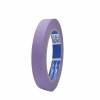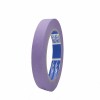The right procedure to place paper tape
How to place paper tape in the correct way? When we think about painting – whether it’s a wall, a piece of furniture, a car’s bodywork, or an industrial component – we tend to focus on the act of painting itself, either by brush, by roller, or by airbrush.
But be careful, the result of this operation actually depends, to a large extent, on the preliminary operations, and then on the preparation of the surface to be painted, the choice of paint and, of course, the application of masking tape, also known as paper tape.
Today, then, we’ll outline how to place paper tape effectively, to avoid compromising the end result.
Why is applying paper tape important?
Applying paper tape before painting is very important. It is easy to see why: no painting tool, from brush to airbrush, makes it possible to get lines as precise as those that can be obtained with quality masking tape.
This applies both to continuous surfaces that must accommodate two or more colours, and for discontinuous surfaces, in which a section must be protected from colouring: think of electric doors or boxes during normal painting work in the house.
Paper tape makes it possible to have fast, perfect, and precise painting, without soiling and without creating unpleasant smudges. Before describing how to place paper tape perfectly, let’s have a look at how to choose masking tape!
Which paper tape to use
There are many different types of masking tape among which to choose the best one for you according to your needs.
There are many factors to keep in mind. First of all, you’ll need to think about the context in which that masking tape will be used, and then the materials with which it will be put in contact, the temperatures to which it will be exposed, as well as any “threats” that could undermine its grip.
It is therefore important to distinguish, for example, between masking tape meant for the indoors or for the outdoors: the latter must be able to give its best even when exposed to ultraviolet rays and must also resist moisture and water. Indoor-use paper tape, however, will have no need to be weatherproof.
It is also good to think about the temperature at which paper tape will be exposed. In most cases masking tape is used at room temperature: normal 60 °C (140 °F) paper tape, designed to be used below this temperature, will be fine.
In other cases – as is the case for industrial processing – it will be necessary to rely on masking tape with a higher temperature resistance, therefore choosing between 80 °C (176 °F) or even 100 °C (212 °F) masking tape (in our e-commerce for online sale of adhesive tape you will be able to find categories dedicated to these special adhesive tape kinds).
It will then be necessary to decide which paper tape to use considering the width, as well as the degree of difficulty of the lines to be drawn: in the case of curvilinear masking is for example possible to take advantage of special tape made with super crepe paper especially created for the masking of curved lines.
How to place paper tape
Let’s outline how to apply paper tape to the surface you need to protect. First of all, it is best to clean this surface perfectly, eliminating dust, grease, or other contaminants. This way, the tape will have more grip, and it will be easier to apply it correctly, following the established line.
To be effective and to avoid smearing, the paper tape must be completely stretched out, without any folds; patiently laying long and single pieces, slowly unrolling the tape, you can get perfectly straight lines of tape.
Once you have applied each strip of paper tape, it is good practice to pass your hand over it, applying slight pressure, to avoid cracks, which could, in turn, give rise to streaks and smudges.
After having applied the adhesive tape in this way, creating straight lines, corners, and possibly curved lines (using crepe paper tape), you can proceed with the painting.
How to remove paper tape after painting
The paper tape must be removed before the paint is completely dry: this will make it easier to do so without removing parts of colour.
But how can you remove masking tape while minimizing the chances of damage to the colour? Well, the important thing is to remove the paper tape starting from an edge and pulling the tape without tearing, in a slow and regular motion.
A tip to avoid streaks and smudges is to proceed at an angle of 45 or more degrees between the tape and the painted surface. This way, you will be able to remove the paper tape without damaging the colour and leaving no residue behind.







